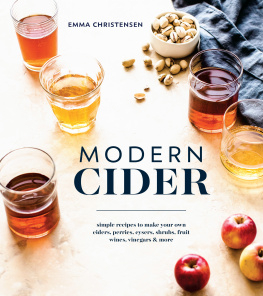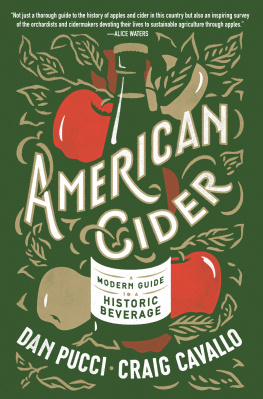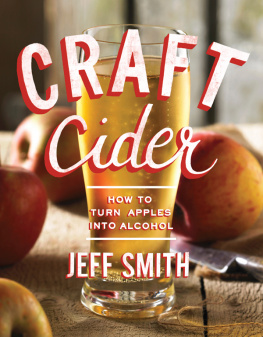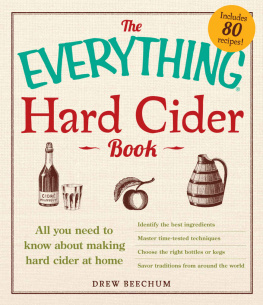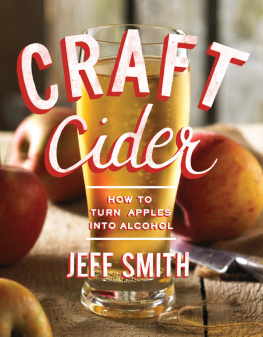TROUBLESHOOTING YOUR HOMEMADE CIDER
Fermentation plays by its own rules and sometimes things pop up that cant be anticipated. Here are the most typical situations that can happen while making a batch of cider, and what to do about them.
IF YOU FORGOT TO SANITIZE YOUR EQUIPMENT
The number-one cause of a spoiled batch of cider is an infection introduced through poor sanitation practices. Get in the habit of sanitizing everything. Obsessively. Always. Its better to be overly cautious about sanitation than to scrimp and wind up with an infection.
This said, if your sanitation is generally good and you accidentally slip up one time, then your cider is probably fine. Yes, theres a little risk that some nasty bacteria slipped in, but probably not. Until you actually see any signs of infection, continue making the cider as usual.
IF YOU ADDED SULFITES, BUT CANT WAIT 24 HOURS FOR THEM TO DISSIPATE
Sulfites take a full 24 hours to clear the cider of any wild yeast or bacteria and then dissipate. If you add the commercial yeast much before the 24 hours are up, any sulfites lingering around might interfere with the start of fermentation. If at all possible, wait a full 24 hours before adding the yeast or up to 36 hours. If you have to add the yeast early for any reason, go ahead and do so, but keep an eye on it. If fermentation doesnt start within a day or two, add more yeast.
IF YOU ADDED SULFITES, BUT FORGOT TO ADD THE YEAST
If its been less than 36 hours, the juice is finego ahead and add the yeast. If its been more than 36 hours, check your juice for any signs of mold or aromas of spoilage. If it seems okay, you can continue. If youre unsure, it might be a good idea to add another dose of sulfites to clear out anything that might have started growing (and then remember to add the yeast).
The 36-hour maximum is a little arbitrary here. Sulfites preserve the juice up to a point, but not indefinitely. Youre usually safe within 36 hours, but beyond that, it can get chancy. Use your best judgment.
IF YOU FORGOT TO PUT LIQUID IN YOUR AIR LOCK
Add sanitizer, vodka, or water up to the fill line as soon as you remember. Theres a small chance that your cider picked up an infection while it was unprotected, but if you caught it within a day or two and fermentation seems to be going strong, youre probably fine. Keep an eye out for signs of infections over the next few weeks (such as weird smells, weird tastes, weird fuzz growing on the surface of the liquid).
IF YOU DONT SEE ANY BUBBLES IN YOUR AIR LOCK AFTER 24 HOURS
Did you remember to add the yeast? Youd be surprised how often this has happened to me, so dont feel sheepish. Just go ahead and add the yeast as soon as you remember. Also, if youre fermenting the cider with wild yeast, remember that fermentation can take a little longer to start. Wait a few more days before you panic.
Is it chilly in your house? If its below 65F, then the yeast can be a little sluggish and slow to get started. Move the cider somewhere warmer, if possible.
If fermentation still hasnt started, then the culprit might be a bad batch of yeast. Pick up some new yeast as soon as you can, double-check the expiration date, and add it to your cider.
IF THE BUBBLING SLOWS DOWN OR STOPS SOONER THAN YOU EXPECTED
This usually means that the active stage of fermentation is close to, or has already, finished. Congrats, youve made cider! If its warm in your house, this stage could happen in just a few days. Let the cider sit for a little longer to give the sediment time to settle, and then transfer it to the jug or carboy.
IF YOU WERE GONE FOR A FEW DAYS AND ARENT SURE IF FERMENTATION HAPPENED
In all likelihood, fermentation did indeed happen and has now slowed or stopped. Check the specific gravity of your cider and give it a taste. If fermentation occurred, then the specific gravity will be significantly lower than when you started. The cider will also taste much less sweet and closer to hard cider.
IF THE BUBBLING DOESNT STOP
Most ciders will finish fermenting within a few weeks and youll see no more bubbles in the air lock. But some ciders take a little longer, especially ones made with wild yeast or that have extra sugar added. If the cider still looks, smells, and tastes okay, then let it continue. Keep a close eye on it and take samples every week or so to check that everything is okay. Malolactic fermentation can also cause some renewed bubble action in the air lock.
In some cases, nonstop bubbling can mean the cider has picked up an infection. This cider will start to smell and taste very disgusting and spoiled, and you might notice mold or oily residue on the surface of the cider. If this happens, its best to toss the batch and start again.
IF THE TEMPERATURE IN YOUR HOUSE IS VERY HOT OR VERY COLD
Yeast is a pretty tolerant organism and will generally do fine at temperatures ranging from 65 to 85F. Above 85F, the yeast will still work, but it gets stressed out and youll start to notice some unpleasant flavors in your cider. If possible, move the cider somewhere cooler, or wrap it in water-soaked towels. On extremely hot days, you can also tuck ice packs into the wet towels to keep the cider cool.
If the temperature drops below 65F, then move your cider to the warmest spot you can find. You can place it near a heater or furnace, or place the cider on a heating pad, but be careful the cider doesnt get too hot. Homebrewing stores also sell special heating pads and wraps for buckets and carboys.
IF YOU FORGOT YOUR CIDER IN THE PRIMARY FERMENTATION BUCKET AND HAVENT TRANSFERRED IT TO THE GLASS JUG OR CARBOY
Thats fine! If its been over a month, fermentation seems complete, and the cider tastes good to you, then go ahead and bottle it. Otherwise, transfer it to a jug or carboy and let it age a little longer. If its been a few months or more in the primary, you might start to notice some odd vegetal flavors caused by the decomposing sediment at the bottom of the bucket or oxidized sherry-like flavors from air seeping through the plastic. If the taste is faint, you can carry on. If its strong, then unfortunately theres not much to be done other than tossing the batch.
IF SOME SEDIMENT GETS TRANSFERRED TO THE JUG OR CARBOY WHILE SIPHONING
This is fine! The primary goal of transferring the cider from the bucket to the jug or carboy is to get it off most of the sediment. But if a little gets transferred as youre siphoning, its no big deal. This sediment will quickly fall to the bottom of the jug or carboy in the next few days.
IF THERES A LOT OF SEDIMENT FLOATING IN YOUR CIDER THAT DOESNT SEEM TO SETTLE
Try chilling the cider in a fridge or a very cold (but not freezing) part of your house. This is called cold crashing, and it can sometimes force those stubborn floating particles to settle on the bottom. Cold crashing wont help if your problem is haziness in the cider, not solid particles, but it also wont hurt.
IF ITS BEEN LONGER THAN 3 MONTHS BEFORE BOTTLING
This is totally fine, and your cider probably tastes even better for the wait. If you want to make a sparkling cider, then be sure to add some new yeast when you bottle because any yeast from earlier in the process has died by now. Use the same yeast in the same amount as at the beginning of fermentation (or use champagne yeast if your cider was naturally fermented).
IF THERE IS MOLD ON THE SURFACE OF YOUR CIDER
This usually occurs only at the beginning of the cider-making process and happens when there is a problem with the yeast. Either you forgot to add the yeast, the yeast was expired, or, if it was a wild yeast fermentation, the yeast didnt get going quick enough before spoilage-causing bacteria took over. In all these cases, youll need to throw away the juice and start over.
Next page
